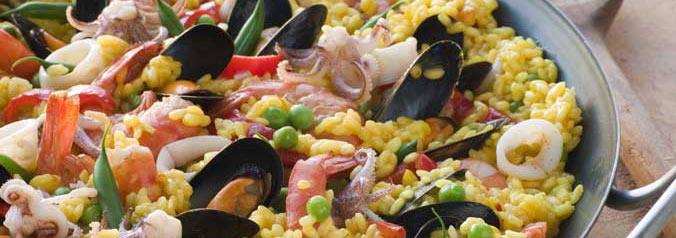Why our customers prefer Blue Cross
- Option of getting insured without a medical exam
- Excellent rates
- Pioneer in the field of health insurance with over 80 years of experience
- Friendly service from experienced agents who can answer your questions and assist you when needed
- Coverage that can be customized to meet your specific needs
- Discounts and savings with our one-of-a-kind Blue Advantage program

Paella Comes to Your Next Barbecue
Published on: June 1, 2014
Barbecue season is in full swing. Why not take the opportunity to surprise your guests with a feast of paella? It's easy to make and tasty to eat. In fact, in Spain, paella is traditionally cooked and eaten outdoors. In this article, you will discover that this dish, loved the world over, is much easier to prepare than you might think.
What are we going to eat? Answering this eternal question is easier when it comes to barbecuing. We first think of grilled meats and sausages, along with vegetables, also grilled. But why not try something out of the ordinary - such as paella!
This dish, from the region of Valencia in Spain, has spread around the world, much like pizza and quiche lorraine. Preparing it on the barbecue is like a homecoming for paella, because it was originally cooked outdoors at picnics. A large skillet (a paellera, or paella in Spanish, hence its name) was placed on a fire of twigs, which imparts a pleasant aroma to the dish. You can buy a paella pan specially designed for this purpose: it's without a handle, but has two fitted rings that make it easier to manipulate. However, any good skillet will do, as long as it is large enough.
The Indispensable Ingredient: Saffron
To make paella, you will need round grain rice, olive oil, various vegetables, meat, seafood, and the essential ingredient: saffron. It is saffron that imparts the beautiful orange tint to the rice and the distinctive flavour to the whole dish. It is rightly said that saffron is the most precious of all spices. However, it takes very little to flavour paella; too much would be counter-productive. But beware of imitations: nothing can substitute for real saffron!
If you have never cooked paella, here is a simple recipe to get you started.
Ingredients for paella for four people, cooked in a pan 30 cm (12 in.) in diameter:
- 6 chicken drumsticks
- Tabasco sauce
- 20 large raw shrimp, unshelled
- Olive oil
- 1 small onion, chopped
- ½ red pepper, seeded and cut into strips
- 1 tomato, chopped
- 1 cup of short grain rice, such as arborio
- 3.5 cups of hot chicken broth (or water)
- ⅔ cup frozen peas
- ¼ tsp (0.15 g) saffron (crush it into a powder if it is not already in that form)
- 20 fresh mussels, rinsed and sealed
- 1 large lemon, quartered (for garnish)
- Salt and pepper (to taste)
Preparation
Preheat the barbecue. Generously salt the chicken drumsticks, pepper them, and season with Tabasco. Brush the shrimp with olive oil. Cook the chicken and shrimp on the grill while you prepare the paella; once the chicken and shrimp are cooked, keep them warm.
In a large skillet, at a medium-high heat (make sure the heat is uniform across the pan), fry the onion and pepper in olive oil for 2 minutes, then add the tomato and cook for another 2 minutes. Add the rice, stirring with a wooden spoon so that it soaks up the oil, and cook for 2 minutes. Pour 1 cup of hot broth over the rice. Continue cooking over low heat, uncovered, making sure that the rice does not stick to the pan. Add hot broth to replace what was lost to evaporation.
After 10 minutes, add the peas. Dissolve the saffron in a little broth (so as to lose none of the precious spice) and pour it into the pan. Add 1 cup of hot broth, then sink the mussels into the rice. Cook for 10 to 15 minutes, until the rice is tender and all of the mussels open up. Add hot broth as needed, but make sure that the paella is neither too dry nor too wet.
Finally, present the paella in the pan after garnishing it with the chicken drumsticks, the shrimp, and the lemon wedges. Serve immediately. Do not forget to provide your guests with a bowl in which they can dispose of the mussel and shrimp shells.
Paella: A Dish that Stimulates the Appetite and Creativity...
Provided you respect the three basic rules - cooking in a large skillet without a lid, using round grain rice, and seasoning with saffron - paella allows you to give free range to your creativity. You can replace the chicken with another meat, mussels with clams, and shrimps with lobster, crab, squid, scallops, or even fish. We often add sliced chorizo (Spanish sausage). Various vegetables can enter into the paella mix: diced carrots, mushrooms, asparagus, artichokes, green beans, etc. One caveat: Limit the choice of ingredients to avoid "overloading" your paella with too many competing flavours. And, of course, only use real saffron.
So, go ahead and personalize the paella at your leisure and... olé!